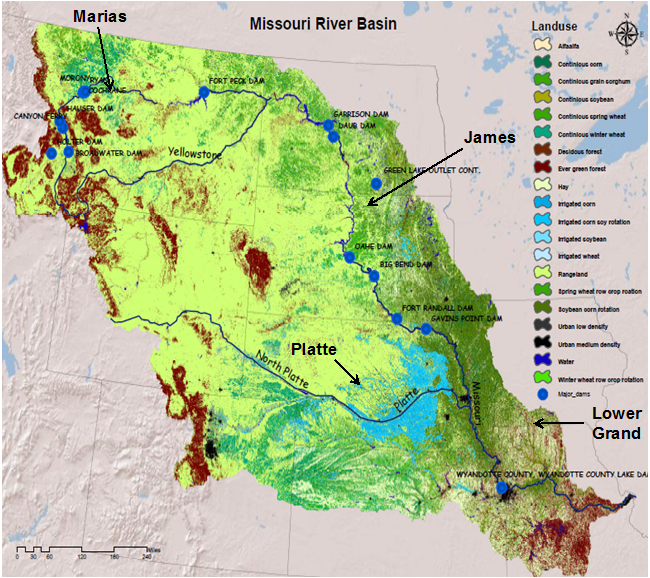Decadal Drought Risk Assessment and Scenario Development for Food and Bio-fuels Agriculture in Four Sub-basins in the Missouri River Basin
Funded by:
National Oceanic and Atmospheric Administration – Climate Program Office – Sectoral Applications Research Program; Sept. 2015 – August 2017
Principal Investigator:
Vikram Mehta, CRCES
Research Associate:
Katherin Mendoza, CRCES
Co-Investigator:
Cody Knutson, National Drought Mitigation Center, Univ. of Nebraska – Lincoln
Proposal Summary
We propose to assess decadal drought information needs of food and bio-fuels agriculture, and develop decadal drought and impacts scenarios in the Marias, James, Central Platte, and Lower Grand sub-basins within the Missouri River Basin (the MRB hereafter). Our previous research has shown that decadal climate variability (DCV) phenomena substantially impact water and crop yields in the MRB, and that decadal droughts and wet spells caused by DCV phenomena substantially impact the agriculture sector. In prior research, we have also assessed MRB-wide need for decadal drought information and found that impacts of DCV phenomena on agriculture are distinctly crop- and region-dependent. Thus, the scientific objectives of the proposed research are: (1) to define decadal drought information needs of agricultural stakeholders in four selected sub-basins of the MRB; and (2) to conduct a scenario-planning exercise for coping with decadal droughts in the four sub-basins selected for study. We will use a variety of climate, hydro-meteorological, agricultural, and water data in this research. Outputs from a 12 km x 12 km version of the well-established Soil and Water Analysis Tool (SWAT) as well as data and methodologies from our current U.S. Department of Agriculture (USDA) funded project focused on the MRB will also be employed in the proposed research. Stakeholders in the selected sub-basins will be involved from the beginning of the proposed research. The assessment, elicitation, and scenario-planning methodologies to be developed in this project will be useful to society in maximizing benefits and minimizing adverse impacts of decadal drought and wet spells on the agriculture and water sectors. Results of the proposed research may also be useful in defining the need for investments in DCV observation and prediction systems.
Results will be published in peer-reviewed scientific journals such as Weather, Climate, and Society; Journal of the American Water Resources Association; and Bulletin of the American Meteorological Society. Articles will also be published in appropriate newsletters. Presentations will be made at national and regional conferences, and at specialty conferences. We will also provide briefings to stakeholders, NOAA program managers and NOAA climate service scientists in the MRB and elsewhere. In addition to the dissemination channels outlined above, the results and recommendations emanating from our study will also be placed on appropriate Web sites.
The proposed research is consistent with the FY2014 SARP emphasis on “Coping with droughts and NIDIS” and is directly relevant to the NIDIS Drought Early Warning Focus Area of Agriculture in the MRB, and will address the following NIDIS objectives: (1) Characterizing climate-related risk perception among stakeholders faced with making decisions in a variable and changing climate; and (2) Developing drought risk scenarios and how these affect water budgets and accounts. Also, the proposed research is highly relevant to NOAA’s long-term goal of developing climate adaptation and mitigation strategies as described in NOAA’s Next-Generation Strategic Plan. The proposed research is also consistent with a recent USDA – NOAA Memorandum of Understanding whose purpose is to provide a framework to meet the weather and climate information needs of Tribes, the agricultural and forestry sectors, rural and urban communities, and other stakeholders.
Project Status
1. Formed Stakeholder Advisory Teams in four sub-basins in the MRB.
 Figure 1: The four sub-basins selected across the MRB: the Marias sub-basin- Musselshell-Poplar in Montana, the James sub-basin in North and South Dakota, the Central Platte sub-basin in Nebraska, and the Lower Grand Basin in Iowa and Missouri.
Figure 1: The four sub-basins selected across the MRB: the Marias sub-basin- Musselshell-Poplar in Montana, the James sub-basin in North and South Dakota, the Central Platte sub-basin in Nebraska, and the Lower Grand Basin in Iowa and Missouri.
2. Started interactions with each Stakeholder Advisory Team.
Stakeholder Advisory Team Spring 2017 presentation summary.
Please see Spring 2017 webinar presentations given to Lower Grand sub-basin, Central Platte sub-basin, James sub-basin, and Marias (TBD) sub-basin Stakeholder Advisory Teams.
Please see Winter 2018 webinar presentations given to Lower Grand sub-basin, Central Platte sub-basin, James sub-basin, and Marias (TBD) sub-basin Stakeholder Advisory Teams.
Please see Spring 2018 webinar presentations given to Lower Grand sub-basin, Central Platte sub-basin, James sub-basin, and Marias sub-basin Stakeholder Advisory Teams.
Please see the Project final report.